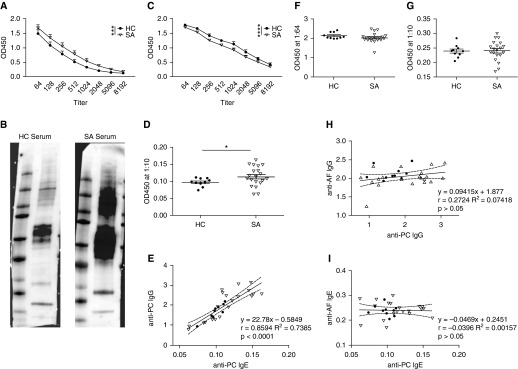Figure 7.
Patients with severe asthma have elevated anti-Pneumocystis (anti-PC) IgG and IgE levels. (A) Serum samples from healthy control subjects (HC) (n = 10) and patients with severe asthma (SA) (n = 20) were analyzed for anti-PC IgG at various dilutions. Patients with SA had increased antibody levels against PC (***P < 0.001 by two-way analysis of variance). (B) Detection of anti-PC IgG from one HC and one patient with SA demonstrates similar banding patterns but increased intensity in the patient with SA. (C) Serum samples from HCs and patients with SA were also analyzed for IgG levels against Streptococcus pneumoniae, and patients with SA had reduced antibody levels (****P < 0.0001 by two-way analysis of variance). (D) Anti-PC IgE could be detected by ELISA in the serum (diluted 1:10) of a subset of patients with SA (*P < 0.05 by Student’s t test). (E) Linear regression and Pearson’s correlation analysis demonstrates a strong correlation between anti-PC IgG and anti-PC IgE levels in all patients (r = 0.8594; P < 0.0001). (F and G) Patients with SA do not have an increase in (F) anti-Aspergillus IgG or (G) anti-Aspergillus IgE. (H) No correlation exists between anti-PC IgG and anti-Aspergillus IgG (r = 0.2724; P > 0.05). (I) No correlation exists between anti-PC IgE and anti-Aspergillus IgE (r = −0.0396; P > 0.05). AF = Aspergillus fumigatus; OD450 = optical density at 450 nm.

